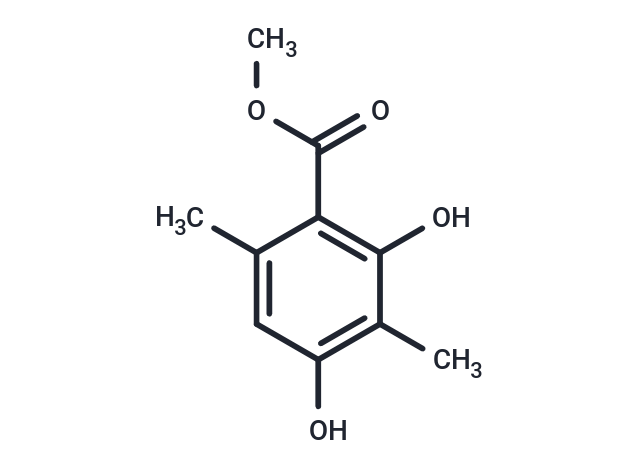Shopping Cart
- Remove All
 Your shopping cart is currently empty
Your shopping cart is currently empty

Atraric acid derivatives as a new chemical lead structure for novel therapeutic compounds as AR antagonists, that can be used for prophylaxis or treatment of prostatic diseases. It inhibits PTP1B activity in a dose-dependent manner with IC50 values of 51.5 uM, suggest that atraric acid has potential to treat diabetes.

| Pack Size | Price | Availability | Quantity |
|---|---|---|---|
| 500 mg | $41 | In Stock | |
| 1 mL x 10 mM (in DMSO) | $45 | In Stock |
| Description | Atraric acid derivatives as a new chemical lead structure for novel therapeutic compounds as AR antagonists, that can be used for prophylaxis or treatment of prostatic diseases. It inhibits PTP1B activity in a dose-dependent manner with IC50 values of 51.5 uM, suggest that atraric acid has potential to treat diabetes. |
| Targets&IC50 | PTP1B:51.5 uM |
| In vitro | Androgen receptor (AR) antagonists are important compounds for the treatment of prostate cancer (PCa). The Atraric acid (AA), a natural compound, binds to the AR and acts as a specific AR antagonist. Interestingly, Atraric acid represents a novel chemical platform that could serve as a potential basis for new AR antagonists. METHODS AND RESULTS:Therefore, one objective of this study was to analyze the chemical/structural requirements for AR antagonism and to obtain predictions of where and how Atraric acid binds to the AR. Further, this study describes the chemical synthesis of 12 Atraric acid derivatives and their analysis using a combination of computational and functional assays. Functional analysis of Atraric acid derivatives indicated that none activated the AR. Both the para-hydroxyl group and the benzene ortho- and the meta-methyl groups of Atraric acid appeared to be essential to antagonize androgen-activated AR activity. Furthermore, extension of the hydrophobic side chain of Atraric acid led to slightly stronger AR antagonism. In silico data suggest that modifications to the basic Atraric acid structure change the hydrogen-bonding network with the AR ligand binding domain (LBD), so that the para-hydroxyl group of Atraric acid forms a hydrogen bond with the LBD, confirming the functional importance of this group for AR antagonism. Moreover, in silico modeling also suggested that the ortho- and meta- methyl groups of Atraric acid interact with hydrophobic residues of the ligand pocket of AR, which might explain their functional importance for antagonism. CONCLUSIONS:Thus, these studies identify the chemical groups of Atraric acid that play key roles in allowing the Atraric acid-based chemical platform to act as an AR antagonist. |
| Molecular Weight | 196.2 |
| Formula | C10H12O4 |
| Cas No. | 4707-47-5 |
| Smiles | COC(=O)C1=C(O)C(C)=C(O)C=C1C |
| Relative Density. | 1.251 g/cm3 |
| Storage | Powder: -20°C for 3 years | In solvent: -80°C for 1 year | Shipping with blue ice. | ||||||||||||||||||||||||||||||
| Solubility Information | DMSO: 13 mg/mL (66.26 mM), Sonication is recommended. | ||||||||||||||||||||||||||||||
Solution Preparation Table | |||||||||||||||||||||||||||||||
DMSO
| |||||||||||||||||||||||||||||||

Copyright © 2015-2025 TargetMol Chemicals Inc. All Rights Reserved.